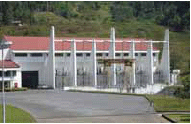Hydropower Programme

Throughout its history, the Mekong River Commission has promoted hydropower as a vital resource that can greatly improve the lives of the millions of people in the Lower Mekong Basin. Today the stance of the MRC on hydropower is very clear. The hydropower potential of the basin is high and has barely been tapped. Meanwhile the energy demands of the region and of its neighbours, particularly China, are soaring, and there are substantial opportunities for trading of power between the countries in the region.
By identifying specific procedures for mainstream projects, the 1995 Agreement recognises there are both opportunities and risks associated with dams on the mainstream of the Mekong River. All the Mekong countries include hydropower options in their development strategies. This power will bring in much needed revenues which will enable the governments of these nations to improve social structures by increasing spending on education, health and internal infrastructure.
The MRC has estimated the sustainable hydropower potential of the basin at around 30,000 MW. Of this 13,000 MW is on the mainstream, 13,000 MW on the Lao tributaries, 2,200 MW on the Cambodian tributaries, and 2,000 MW on the Vietnamese tributaries. To date 11 schemes have been completed in the LMB totalling some 1,600 MW or 5% of the potential. All of these are tributary projects. In 2007 project development accelerated rapidly, both for schemes on tributaries and on the Mekong mainstream. In the Lao PDR in particular, hydropower plans have been revised to more ambitious levels.
Successful development of the basinís power potential requires a well-structured and integrated programme founded on basin-wide planning, with due regard to environmental and social aspects. The current MRC hydropower development strategy was formulated in 2001. Further work was conducted in 2005, when the Secretariat established a hydropower task force and developed a project database covering existing and proposed schemes above 5 MW. A concept paper for a Hydropower Programme was developed and approved in August 2005, but the programme did not begin due to lack of funding.
In 2007 donor funding for this important programme was finally secured from several sources: France, the Japan- ASEAN Integration Fund, and Finland, all made contributions towards the start-up of an MRC Hydropower Programme. This will allow the organisation to conduct a comprehensive and inclusive formulation process and start activities in highpriority areas. The programme will establish cooperation structures with hydropower bodies in the member countries and provide advice on the planning, construction, and operation of hydropower plants and dams, using the MRCís extensive records and data but also conducting supplementary studies to analyse the options for sustainable hydropower.


The Secretariat has at least three roles in assessing and advising on hydropower opportunities and risks. One relates to the analysis of projects implications, including the cumulative effects of national projects. Another is to provide advice on specific projects where requested.The third relates to administering the formal notification and consultation procedures under the 1995 Agreement, and where required providing technical advice under such procedures and facilitating negotiation of agreements. Stakeholder participation in hydropower development will be encouraged. To this end the MRC has formed a partnership with the Worldwide Fund for Nature and the Asian Development Bank to assess environmental considerations for sustainable hydropower development.
A taskforce will engage the hydropower industry, governments and international and local stakeholders to improve planning for hydro projects so that the manifold benefits will minimise any negative impacts. MRC involvement in the hydropower sector will focus on the strengthening of basin-wide cooperation between line agencies in the energy and water related sectors, and with the private sector, as well as helping the Member States to address issues by taking a broad perspective on all options, and by considering the sustainable development of water resources in general.
Activities during the coming year will fall under four broad thematic headings: Firstly, Hydropower Programme Formulation: a participatory programme will be formulated with the Member States, and with other stakeholders, taking note of relevant developments in the Lower Basin and in upper riparian countries. The strategic orientation of the programme will be redefined and detailed by drafting a programme document and implementation plan.

Secondly, the concept of the MRC geo-spatial database of hydropower developments in the region will be improved by reviewing and complementing current data holdings, and by providing guidance for the collection of additional data. Thirdly, hydro developments will be included in basin-wide multi-sector planning, as part of phase two of the MRC Basin Development Plan process. This will involve making an initial strategic-level assessment of existing and planned hydropower and multi-purpose schemes in the Lower Mekong Basin, and in the upper riparian countries, with a particular focus on cumulative and trans-boundary impacts. It shall also define and analyse hydropower development scenarios for several time horizons, apply and guide further development of the MRCís assessment methodologies and tools, and advise on best practices and new approaches in planning, civil society participation, and integration of economic, social and environmental issues and concerns.
Finally, technical assistance on specific hydropower issues will be provided at the request of Member States. The MRC can supply expert opinion on regional and country developments or on individual schemes, taking a pro-active role in the technical appraisal of notifications, and facilitating mutual and balanced decision making.
Choose a newsletter: